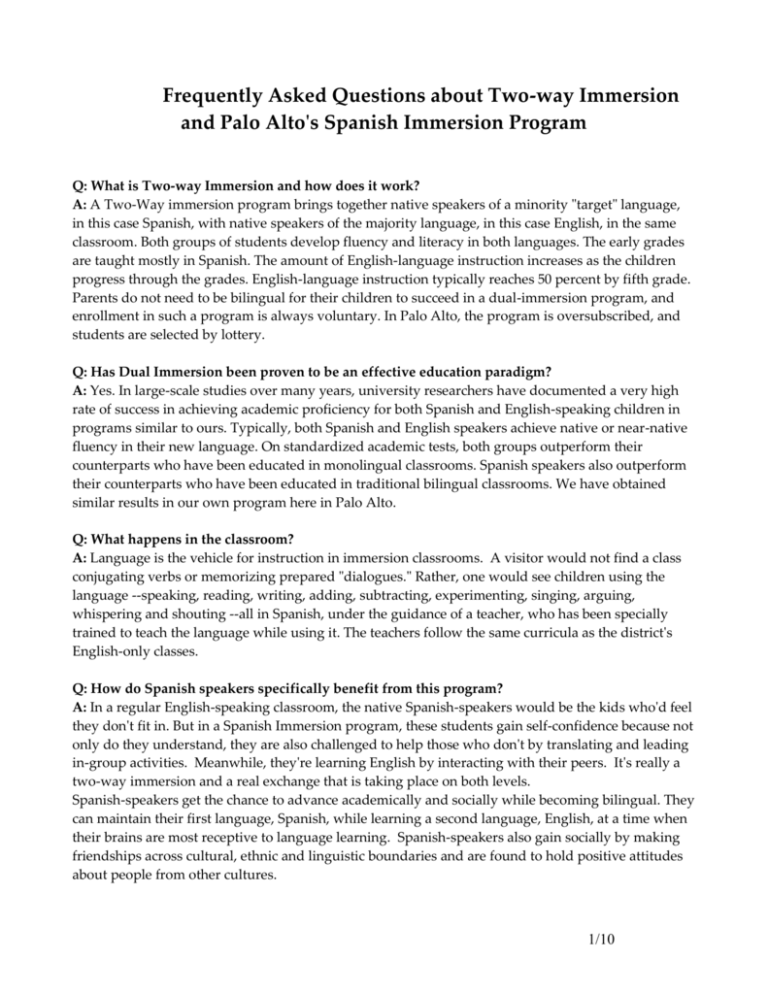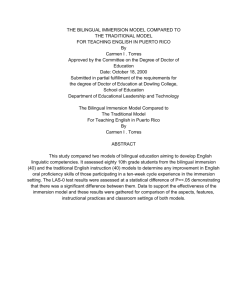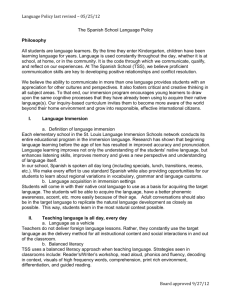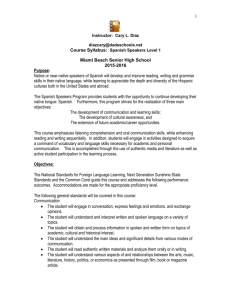sifaqs2012-eng
advertisement

Frequently Asked Questions about Two-way Immersion and Palo Alto's Spanish Immersion Program Q: What is Two-way Immersion and how does it work? A: A Two-Way immersion program brings together native speakers of a minority "target" language, in this case Spanish, with native speakers of the majority language, in this case English, in the same classroom. Both groups of students develop fluency and literacy in both languages. The early grades are taught mostly in Spanish. The amount of English-language instruction increases as the children progress through the grades. English-language instruction typically reaches 50 percent by fifth grade. Parents do not need to be bilingual for their children to succeed in a dual-immersion program, and enrollment in such a program is always voluntary. In Palo Alto, the program is oversubscribed, and students are selected by lottery. Q: Has Dual Immersion been proven to be an effective education paradigm? A: Yes. In large-scale studies over many years, university researchers have documented a very high rate of success in achieving academic proficiency for both Spanish and English-speaking children in programs similar to ours. Typically, both Spanish and English speakers achieve native or near-native fluency in their new language. On standardized academic tests, both groups outperform their counterparts who have been educated in monolingual classrooms. Spanish speakers also outperform their counterparts who have been educated in traditional bilingual classrooms. We have obtained similar results in our own program here in Palo Alto. Q: What happens in the classroom? A: Language is the vehicle for instruction in immersion classrooms. A visitor would not find a class conjugating verbs or memorizing prepared "dialogues." Rather, one would see children using the language --speaking, reading, writing, adding, subtracting, experimenting, singing, arguing, whispering and shouting --all in Spanish, under the guidance of a teacher, who has been specially trained to teach the language while using it. The teachers follow the same curricula as the district's English-only classes. Q: How do Spanish speakers specifically benefit from this program? A: In a regular English-speaking classroom, the native Spanish-speakers would be the kids who'd feel they don't fit in. But in a Spanish Immersion program, these students gain self-confidence because not only do they understand, they are also challenged to help those who don't by translating and leading in-group activities. Meanwhile, they're learning English by interacting with their peers. It's really a two-way immersion and a real exchange that is taking place on both levels. Spanish-speakers get the chance to advance academically and socially while becoming bilingual. They can maintain their first language, Spanish, while learning a second language, English, at a time when their brains are most receptive to language learning. Spanish-speakers also gain socially by making friendships across cultural, ethnic and linguistic boundaries and are found to hold positive attitudes about people from other cultures. 1/10 Q: How do English speakers specifically benefit from this program? A: English speakers get the chance to acquire a new language in the years when their brains are most receptive to language learning. Most become highly proficient in the target language, a standard that most adult Americans, who typically began to study a foreign language in middle or high school, can never hope to attain. English speakers also gain socially by making friendships across cultural, ethnic, and linguistic boundaries. Researchers who study this phenomenon find that English speakers in language-immersion programs hold positive attitudes about people from other cultures. Perhaps State Superintendent Delaine Eastin said it best, in an August. 13, 1997, interview with the Palo Alto Weekly "English-only is a formula for no sales in a global economy. We ought to be talking about how every child can be in a bilingual setting. My niece is in River Glen, a school in San Jose, and she was fluent in Spanish by third grade. The Anglo kids are learning Spanish, and the Spanish-speaking kids are learning English, and everybody is having a great time. Scores are way up for these children.” Q: How do children who are already bilingual benefit from this program? A: Dual Immersion programs allow bilingual children to continue to develop their speaking skills and to learn to read and write in both languages. Q: Is this method of early language learning in wide use? A: In short, yes. There are more than 300 elementary language Dual Immersion Programs throughout the United States, according to the Center for Applied Linguistics in Washington, D.C. There are Dual Immersion programs in many languages, but the most common by far is Spanish. The model was developed in the 1970s in Quebec, Canada, where it is still used extensively to develop bilingualism in French and English-speaking students. Q: Are there local models of successful language immersion programs? A: Fiesta Gardens School in San Mateo and River Glen School in San Jose, the school to which Superintendent Eastin refers above, are two examples of successful Spanish Dual Immersion schools. Escondido School has been instrumental in guiding Menlo Park and Burlingame school districts through the adoption of Spanish Immersion programs in their respective districts. Other nearby programs are in Redwood City, Mountain View, Half Moon Bay, Santa Cruz, San Francisco, Windsor (Sonoma County) and Davis. Q: How did Palo Alto's Spanish Immersion program get started? A: Our program began in the 1995-96 school year, but its roots go back to 1994, when a district task force recommended Dual Immersion as the most effective and least costly method of elementary second language instruction. After two years at Fairmeadow School, our program is now a part of Escondido School. Q: Who are the children and staff of Palo Alto's Spanish Immersion program? A: About one third of the program's students begin school as Spanish-speaking or bilingual, and the other two thirds are native English speakers. Our teachers are dedicated, creative, and trained in immersion techniques. All are completely fluent in English and Spanish. 1/10




